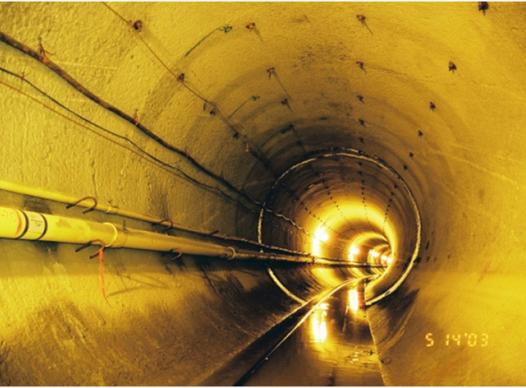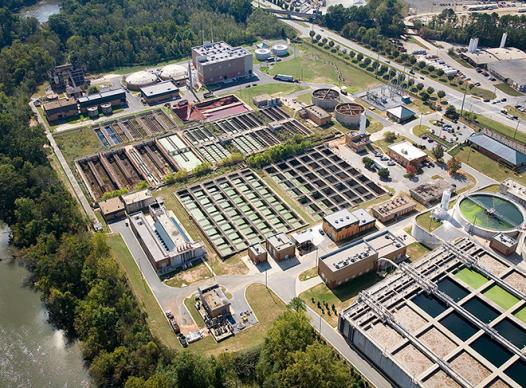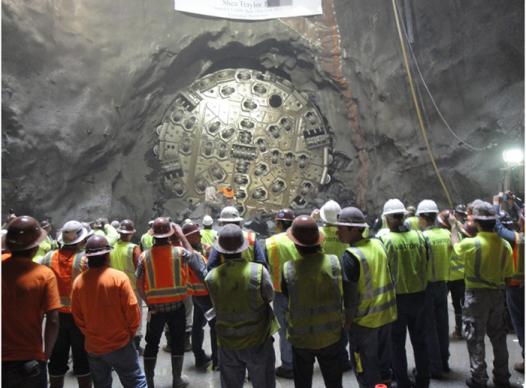Past Projects
Chattahoochee Tunnel
The Chattahoochee Tunnel project, the Cobb County Water System’s first deep tunnel, exemplifies Cobb County’s commitment to be good environmental stewards by utilizing proactive planning to keep pace with continued growth. The goal was to provide sufficient build-out sewer conveyance capacity in east Cobb by relieving the Rottenwood Creek, Sope Creek, and Chattahoochee Interceptors, which were near capacity. Options evaluated included conventional open-cutting, a deep tunnel, and a combination of both methods. The tunnel, with the least amount of environmental and community impacts, was ultimately selected.
The Chattahoochee Tunnel is nearly 9.5 miles long and ranges in depth from 100 to 375 feet below ground surface. The excavated diameter is 18 feet, and approximately 75 percent of the tunnel was lined with concrete to a finished diameter of 16 feet. Construction began in 2000, and it took four and a half years to complete. The project included excavation of the 100-foot diameter, 170 foot deep Pump Station Shaft at the R.L. Sutton Water Reclamation Facility and two 32-foot diameter construction shafts, which were used for staging tunnel boring machine (TBM) construction. The Chattahoochee Tunnel was constructed in three sections: one 1,300-foot drill and blast section (between the Pump Station Shaft and the Elizabeth Lane Shaft) and two drilled sections that were excavated using large tunnel boring machines. The South TBM Drive was staged from the 180-foot deep Elizabeth Lane Construction Shaft. The North Drive was staged from the 230-foot deep Circle 75 Parkway Construction Shaft. At the peak of production, approximately 220 people, including construction workers, engineers, geologists, and support staff, worked on the project. The final construction cost was $110.8 million, which was almost $3 million below the original contract amount.
At the northern end of the Chattahoochee Tunnel, sewage from the Sope Creek and Sewell Mill Creek Interceptors drop into the tunnel through the Indian Hills Intake Structure. Two other intakes are located along the tunnel alignment, one at the Rottenwood Creek Interceptor and another at the Little Nancy Creek Interceptor. A fourth intake diverts sewage from the Chattahoochee Interceptor to a 900-foot long, 8-foot finished diameter tunnel, which joins the Chattahoochee Tunnel at its southern end. Each intake consists of a subsurface drop structure, a small drop shaft, and a receiving chamber at tunnel level. The tunnel conveys the wastewater to the R.L. Sutton Water Reclamation Facility where it is treated and discharges to the Chattahoochee River. To view a map of the project, click here.
Jordan, Jones & Goulding (now Jacobs) designed the project and provided full-time construction engineering services. Parsons Engineering Science (now Parsons) and Jacobs Associates were the construction managers for the project. Gilbert/Healy L.P. (a partnership between Gilbert Southern and S.A. Healy) was the contractor.

R.L. Sutton WRF
R.L. Sutton Wastewater Reclamation Facility (WRF)
Solids Handling Facility
After construction of the R.L. Sutton Water Reclamation Facility new liquid process treatment system was completed in December 2004, construction began on a new solids processing facility in February 2005 at a contract price of $56,890,000. The facility includes a Solids Handling Building that houses two new fluidized bed incinerators and a dewatering system consisting of four centrifuges, cake pumps and screw feeders, sludge silos, polymer system, and controls. A sludge thickening system, odor control, sludge feed system, and gravity thickeners complete the construction scope. The new incineration system was successfully placed into operation in June 2008. The upgrade for this facility was completed in June 2009.

South Cobb WRF
The South Cobb Wastewater Reclamation Facility (WRF) Upgrade project, constructed by Brasfield & Gorrie at a contract amount of $33M was completed on schedule in November 2011. This upgrade did not increase the hydraulic capacity of the overall treatment facility; rather, it enhances the plant's ability to meet major-spill requirements of the discharge permit and improve secondary treatment reliability. The construction of a fifth secondary clarifier reduced the hydraulic and solids loading rate among the clarifiers and the addition of effluent filters to the process train provides further removal of solids and phosphorous.
The major components of the Upgrade project are outlined below.
- One 135-foot diameter Secondary Clarifier with an associated Return Sludge Pump Station utilizing vertical turbine solids handling pumps.
- Seven low-head type automatic backwash effluent filters.
- Effluent flow measurement via rectangular venturi-type flow meters.
- Filtered effluent pumping station rated at 100 MGD, consisting of five 200 HP vertical, mixed flow pumps with variable speed drives.
- Plant Recycle pumping station consisting of five 50 HP vertical turbine solids-handling pumps with variable speed drives.
- Plant Reuse Water pumping station.
South Cobb Tunnel
After the success of the Chattahoochee Tunnel project, the Cobb County Water System (CCWS) determined that a deep tunnel would be the best alternative for providing needed sewer capacity in the south Cobb area. The South Cobb Tunnel is the largest capital improvement project in CCWS history. A $305,000,000 construction contract was awarded to Shea-Traylor J.V. (a joint venture of J.F. Shea Construction and Traylor Brothers) on March 26, 2008. Construction started in July 2008, and the tunnel portion of the contract was completed in May 2013, which was about a year ahead of schedule.
The South Cobb Tunnel project entailed constructing a 5.5 mile tunnel located in hard rock, with depths ranging from 150 feet to 400 feet. The tunnel was excavated using the large tunnel boring machine pictured below. The excavated diameter is 27 feet, and approximately 75 percent of the tunnel was lined with concrete to a finished diameter of 24 feet. Several six-foot diameter tunnels and one ten-foot diameter tunnel with lengths ranging from 100 to 3,200 linear feet were constructed also. This project allowed CCWS to eliminate two major pumping stations and about 87,000 linear feet of aging sewer lines and force mains.
The main tunnel alignment begins near the intersection of Maxham Road and Old Alabama Road continues southeast along the county line then turns east just north of I-20 and continues east to the South Cobb WRF. To view a map of the project click here.
The project also included building a deep lift station with a capacity of 130 million gallons per day at the South Cobb Water Reclamation Facility (WRF) to convey wastewater flows from the tunnel to the plant for treatment. The lift station is 100 feet in diameter and 200 feet deep.

The major projects undertaken by the Cobb County Water System typically involve upgrades or expansions to our four water reclamation facilities, but also include large-diameter tunnel projects to provide wastewater conveyance and flow equalization storage capacity. Other typical construction projects include water main repairs/replacements, sewer line extensions, and sewer line rehabilitation. To view a map of current Cobb Water System construction projects, please click here. Currently, there is no major project.
